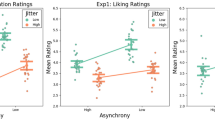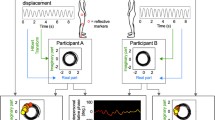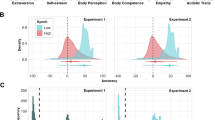Abstract
In activities such as dancing and sports, people synchronize behaviors in many different ways. Synchronization between people has traditionally been characterized as either perfect mirroring (1:1 in-phase synchronization, spontaneous synchrony, and mimicry) or reflectional mirroring (1:1 antiphase synchronization), but most activities require partners to synchronize more complicated patterns. We asked visually coupled dyads to coordinate finger movements to perform multifrequency ratios (1:1, 2:1, 3:1, 4:1, and 5:1). Because these patterns are coordinated across and not just within individual physiological and motor systems, we based our predictions on frequency-locking dynamics, which is a general coordination principle that is not limited to physiological explanations. Twenty dyads performed five multifrequency ratios under three levels of visual coupling, with half using a subcritical visual information update rate. The dynamical principle was supported, such that multifrequency performance tends to abide by the strictures of frequency locking. However, these constraints are relaxed if the visual information rate is beyond the critical information update rate. An analysis of turning points in the oscillatory finger movements suggested that dyads did not rely on this visual information to stabilize coordination. How the laboratory findings align with naturalistic observations of multifrequency performance in actual sports teams (Double Dutch) is discussed. Frequency-locking accounts not only for the human propensity for perfect mirroring but also for variations in performance when dyads deviate from mirroring.








Similar content being viewed by others
References
Albert NB, Ivry RB (2009) The persistence of spatial interference after extended training in a bimanual drawing task. Cortex 45:377–385
Amazeen PG (2002) Is dynamics the content of a generalized motor program for rhythmic interlimb coordination? J Mot Behav 34:233–251
Amazeen PG, Schmidt RC, Turvey MT (1995) Frequency detuning of the phase entrainment dynamics of visually coupled rhythmic movements. Biol Cybern 72:511–518
Amazeen PG, Amazeen EL, Turvey MT (1998) Dynamics of human intersegmental coordination: Theory and research. In: Rosenbaum DA, Collyer CE (eds) Timing of behavior: Neural, computational, and psychological perspectives. MIT, Cambridge, pp 237–259
Amazeen PG, Amazeen EL, Beek PL (2001) Coupling of breathing and movement during manual wheelchair propulsion. J Exp Psychol Hum Percept Perform 27:1243–1259
Bak P (1986) The devil’s staircase. Phys Today 39:38–45
Card S, Moran TP, Newell A (1983) The psychology of human computer interaction. Lawrence Erlbaum Associates, Mahwah
Chartrand TL, Bargh JA (1999) The chameleon effect: The perception-behavior link and social interaction. J Pers Soc Psychol 76:893–910
Cooke NJ, Gorman JC, Myers CW, Duran JL (2013) Interactive team cognition. Cognitive Science 37:255–285
deGuzman GC, Kelso JAS (1991) Multifrequency behavioral patterns and the phase attractive circle map. Biol Cybern 64:485–495
Fontaine RJ, Lee TD, Swinnen SP (1997) Learning a new bimanual coordination pattern: Reciprocal influences of intrinsic and to-be-learned patterns. Can J Exp Psychol 51:1–9
Gibbons CT, Likens AD, Amazeen PG (2015) Multifrequency coordination in dyads. In: Weast-Knapp J, Malone M, Abney D (eds) Studies in perception & action XIII. Taylor & Francis Group, LLC, New York, NY
Gipson CL, Gorman JC, Hessler ER (2016) Top-down (prior knowledge) and bottom-up (perceptual modality) influences on spontaneous interpersonal coordination. Nonlinear Dynam Psychol Life Sci 20:193–222
Glazier JA, Libchaber A (1988) Quasi-periodicity and dynamical systems. IEEE Trans Circ Syst 35:790–809
Gonzales LM, Hessler EE, Amazeen PG (2010) Perceptual constraints on frequency ratio performance in motor-respiratory coordination. Ecol Psychol 22:1–24
Gorman JC (2014) Team coordination and dynamics: two central issues. Curr Direct Psychol Sci 23:355–360
Gorman JC, Crites MJ (2015) Learning to tie well with others: Bimanual versus intermanual performance of a highly practised skill. Ergonomics 58:680–697
Hajnal A, Richardson MJ, Harrison SJ, Schmidt RC (2009) Location but not amount of stimulus occlusion influences the stability of visuo-motor coordination. Exp Brain Res 199:89–93
Hessler EE, Amazeen PG (2014) Learning and transfer in motor-respiratory coordination. Hum Mov Sci 33:321–342
Hessler EE, Gonzales LM, Amazeen PG (2010) Displays that facilitate performance of multifrequency ratios during motor-respiratory coordination. Acta Psychol 133:96–105
Hochberg J (1986) Representation of motion and space in video and cinematic displays. In: Boff KR, Kaufmann L, Thomas JP (eds) Handbook of perception and human performance. Wiley, New York, pp 22–1-22-64
Kelso JAS (1984) Phase transitions and critical behavior in human bimanual coordination. Am J Physiol 246:R1000–R1004
Kelso JAS (1995) Dynamic patterns: the self-organization of brain and behavior. MIT, Cambridge
Lee TD, Swinnen SP, Verschueren S (1995) Relative phase alterations during bimanual skill acquisition. J Mot Behav 27:263–274
Mechsner F, Kerzel D, Knoblich G, Prinz W (2001) Perceptual basis of bimanual coordination. Nature 414:69–73
Ouiller O, de Guzman GC, Jantzen KJ, Lagarde J, Kelso JAS (2008) Social coordination dynamics: measuring human bonding. Soc Neurosci 3:178–192
Peper CE, Beek PJ, van Wieringen PCW (1995) Multifrequency coordination in bimanual tapping: Asymmetrical coupling and signs of supercriticality. J Exp Psychol Hum Percept Perform 21:1117–1138
Pikovsky A, Rosenblum M, Kurths J (2001) Synchronization: A universal concept in nonlinear science. Cambridge University Press, Cambridge
Ramachandran VS, Gregory RL (1991) Perceptual filling in of artificially induced scotomas in human vision. Nature 350:699–702
Richardson MJ, Marsh KL, Isenhower RW, Goodman JRL, Schmidt RC (2007) Rocking together: dynamics of intentional and unintentional interpersonal coordination. Hum Mov Sci 26:867–891
Schmidt RC, Carello C, Turvey MT (1990) Phase transitions and critical fluctuations in the visual coordination of rhythmic movements between people. J Exp Psychol Hum Percept Perform 16:227–247
Strogatz S (2003) Sync: the emerging science of spontaneous order. Hyperion, New York
Swinnen SP, Lee TD, Verschueren S, Serrien J, Bogaerds H (1997) Interlimb coordination: Learning and transfer under different feedback conditions. Hum Mov Sci 16:749–785
Treffner PJ, Turvey MT (1993) Resonance constraints on rhythmic movement. J Exp Psychol Hum Percept Perform 19:1221–1237
Tuller B, Kelso, J. A. S. (1989) Environmentally-specified patterns of movement coordination in normal and split-brain subjects. Exp Brain Res 75:306–316
Varlet M, Richardson MJ (2015) What would be Usain Bolt’s 100-meter sprint world record without Tyson Gay? J Exp Psychol Hum Percept Perform 41:36–41
Varlet M, Bucci C, Richardson MJ, Schmidt RC (2015) Informational constraints on spontaneous visuomotor entrainment. Hum Mov Sci 41:265–281
Washburn A, Coey CA, Romero V, Richardson MJ (2014) Visual multifrequency entrainment: Can 1:2, 2:3, and 3:4 coordination occur spontaneously? J Mot Behav 46:247–257
Yamanishi J, Kawato M, Suzuki R (1980) Two coupled oscillators as a model for the coordinated finger tapping by both hands. Biol Cybern 37:219–225
Zanone PG, Kelso JAS (1992a) Evolution of behavioral attractors with learning: Nonequilibrium phase transitions. J Exp Psychol Hum Percept Perform 18:403–421
Zanone PG, Kelso, JAS (1992b) Learning and transfer as dynamical paradigms for behavioral changes. In: Stelmach GE, Requin J (eds) Tutorials in motor behavior: II. North-Holland, Amsterdam, pp 563–582
Zanone PG, Kelso JAS (1997) Coordination dynamics of learning and transfer: Collective and component levels. J Exp Psychol Hum Percept Perform 23:1454–1480
Acknowledgements
This material is based upon work supported by the National Science Foundation under Grant Number BCS 1257112 (to J. Gorman) and BCS 1255922 (to P. Amazeen). Any opinions, findings, and conclusions or recommendations expressed in this material are those of the authors and do not necessarily reflect the views of the National Science Foundation. The authors are grateful to Aaron Likens and Cameron Gibbons for their contributions to this research.
Author information
Authors and Affiliations
Corresponding author
Rights and permissions
About this article
Cite this article
Gorman, J.C., Amazeen, P.G., Crites, M.J. et al. Deviations from mirroring in interpersonal multifrequency coordination when visual information is occluded. Exp Brain Res 235, 1209–1221 (2017). https://doi.org/10.1007/s00221-017-4888-5
Received:
Accepted:
Published:
Issue Date:
DOI: https://doi.org/10.1007/s00221-017-4888-5




